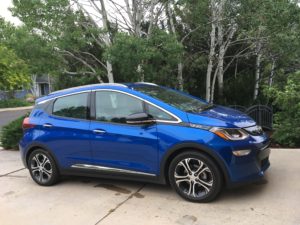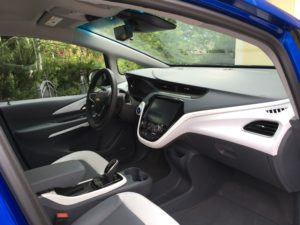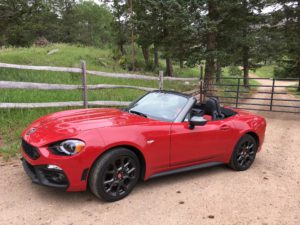
Most surprising to me of the 2017 Chevy Bolt Electric hatchback is its immediate acceleration burst; it’s also comfortable, fun to drive and will carry its driver around 250 miles on a single charge.
Colorado in May became the 17th state in which the Bolt subcompacts are being sold.
Helped by the boost from this state in June, the Bolt nationally outsold the Nissan Leaf, 1,642 to 1,506, third-best among battery electric vehicle sales behind the Tesla Model S and Model X. Total sales of all-electric cars during the month were 8,814 – sure, it’s an increase, but in proper perspective it is about six-tenths of 1 percent of new light duty vehicle sales in the U.S. for the month.
“This will be a game-changer for Chevrolet,” said dealer Kent Bozarth three months ago, as the fully electric Bolt was proving quite an attraction at the Denver Auto Show.

He may be right. It is the first affordable, long-range electric auto from an American manufacturer, and for all it offers and at what cost, it is the best available at this time.
The 2017 Bolt EV Premier showed up with a sticker price of $43,905, and purchasers are eligible for a $7,500 federal tax credit. A cheaper LT version starts around $36,000, less the federal tax credit.
The Bolt is ahead of the pack, for now; its lead may soon be challenged, as Tesla expects to begin production this summer of its Model 3, which claims more than 200 miles on a charge and starting price in neighborhood of $35,000. The next generation Nissan Leaf, with performance capabilities similar to the Bolt, may be ready by September. Other EVs are expected in the months beyond that.
The front-drive Bolt, built at Orion Township, Mich., is only 164 inches in overall length, with a wheelbase of 102.4 inches. Curb weight is 3,563 pounds.

Propulsion comes from an electric motor under the hood capable of producing 200 horsepower and 266 lb.-ft. of torque with a 1-speed direct-drive transmission. Chevrolet’s first shift and park-by-wire system sends electronic signals to the Bolt EV’s drive. It will sprint 0 to 60 in less than 7 seconds.
The battery pack, very flat, spans the entire length of the vehicle’s floor, leaving a roomy seating area both front and back. GM warranties the battery pack for eight years or 100,000 miles. Replacement cost for the battery pack is $15,000, giving a clue as to why resale prices on used electrics are relatively low.
Only once during my six days with the Bolt was the range of available miles depleted more than actual miles driven, and it was in a big way. A 50-mile trip from Greeley to Denver cut 93 miles from the remaining range. Otherwise, the Bolt’s overall range extended beyond its EPA-estimated 238 miles for the full charge.
“The combination of higher speeds on E470 (78 miles per hour), an elevation gain of 600 feet between Greeley and Denver, and a hot day (temperatures in the 90s) may have been cause of the excess range used,” said Fred Ligouri, Chevy Bolt communications chief.
For 240 miles driven last week, the Bolt’s onboard energy summary indicated it had used 51 kWh, or kilowatt hours, of energy.
Recharging the battery pack would be impractical for a home’s standard 110-volt system (would require as long as 57 hours for full charge). An onboard charger for regular overnight charging from a 240-volt wall box is standard, and, with it, a typical commute of 50 miles can be recharged in less than two hours. Fast-charging stations can charge up to 90 miles of range in 30 minutes. The car’s regenerative braking system helps maintain a normal range availability.
A sharply sloped windshield and short hood up front and chopped-off rear end give the Bolt a differing exterior look from more conventional subcompacts. The roomy rear seat loses some appeal from a very straight, upright seatback. Seventeen cubic feet of cargo space is available under the hatch.
The Premier version of the Bolt included lane-keeping assist, surround vision, leather seating, air conditioning, Bluetooth, Apple Carplay capability and Android Auto capability. It had no navigation setup.
